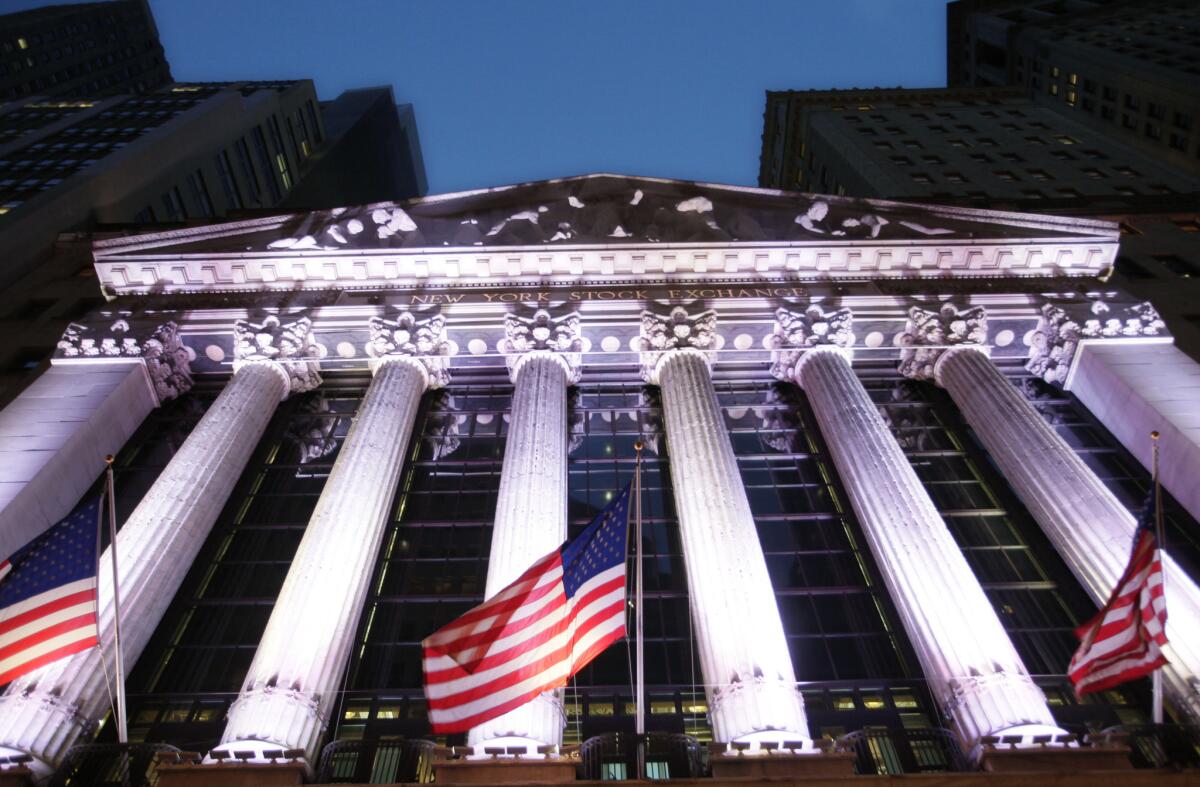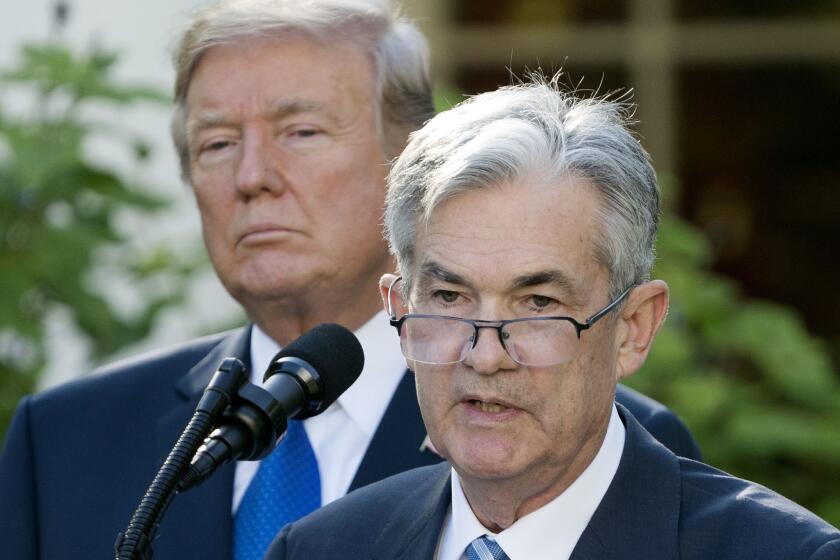Stocks drop as Trump trade war and tantrums undo Fed’s efforts

- Share via
Any reassurance that markets got from the Federal Reserve on Friday was wiped out within minutes. A volley of acrimonious tweets from President Trump and a nasty turn in the U.S.-China trade war sent stocks, Treasury yields and the dollar skidding into the weekend.
Hopes that the nation’s central bank could guide markets to a cool-headed assessment of the U.S. economy now look precarious. Fed Chairman Jerome Powell, whom Trump appointed last year, had barely finished speaking at the Fed’s annual event when Trump unleashed a Twitter tirade against him. The 10-year Treasury yield slid to 1.5%, stocks tumbled and the dollar sank toward its 2019 lows versus the yen.
The broad sell-off in stocks sent the benchmark Standard & Poor’s 500 index to its fourth weekly loss in a row. The index fell 75.84 points, or 2.6%, to 2,847.11 on Friday. It’s down 4.5% for the month but still up 13.6% for the year.
The Dow Jones industrial average dropped as much as 745 points before ending the day with a loss of 623.34 points, or 2.4%, at 25,628.90. The blue-chip index has had five declines of 2% or more this year; three of those have been this month.
The Nasdaq sank 239.62 points, or 3%, to 7,751.77. The Russell 2000 index of smaller-company stocks skidded 46.52 points, or 3.1%, to 1,459.49.
The stocks’ swings came as Trump, the leader of the world’s largest economy, took to social media to order U.S. companies to start looking for alternatives to making products in China. U.S. markets shut for the week just before the president announced another ramp-up in tariffs on Chinese goods. The drama could escalate further this weekend in France as the Group of Seven economic powers meets.
Trump also tweeted Friday morning that he was “ordering” UPS, FedEx and Amazon to block any deliveries from China of the powerful opioid drug fentanyl. All three companies’ stocks fell as traders tried to assess the possible implications, and they all ended the day down more than 3%.
Matt Arnold, an analyst who covers FedEx and UPS for Edward Jones, said it could be difficult for the companies to comply if the administration drafts detailed guidelines for rooting out fentanyl.
“It’s difficult to picture a scenario where UPS and FedEx are all that well-equipped to detect something like this,” he said.
A new Twitter tirade from the White House follows Beijing’s retaliatory tariffs and the Fed chair’s speech at an economic conference.
Technology companies, which have much to lose in the trade war, bore the brunt of Friday’s sell-off. Apple shares slid 4.6%, and Microsoft stock lost 3.2%. Shares of chipmaker Nvidia dropped 5.3%.
Companies that rely on consumer spending also took losses. L Brands, the parent of Victoria’s Secret and Bath & Body Works, sank 9.3%.
Energy stocks headed lower along with crude oil prices. The price of benchmark crude sank $1.18, or 2.1%, to settle at $54.17 a barrel as traders worried that the escalation in the trade war could sap global demand for energy.
Gold, a haven for investors during times of market turbulence and economic weakness, rose $29.30 to $1,526.60 per ounce.
U.S. bonds are also seen as a haven, and their prices rose sharply, sending yields lower. The yield on the 10-year Treasury fell to 1.53% from 1.61%, a large move. Banks fell because lower yields can translate to a decline in the interest rate that lenders charge for mortgages and other consumer loans. JPMorgan Chase shares lost 2.5%, and Citigroup stock dropped 3.1%.
“One hundred percent of the focus for the next few days is going to be on the trade war,” said Gary Cameron, head of the U.S. rates team at Garda Capital Partners. “There’s going to remain a bid in U.S. Treasuries. It’s paid to buy the dip all year long.”
The fixed-income portfolio manager expects that the Federal Reserve’s key policy rate — the interest rate range also known as the federal funds rate — is headed to zero. He said markets are calling the path right for this year. Futures are priced for the Fed’s target to fall about 64 additional basis points by the end of December.
And in Cameron’s view it’s not just the weight of global events dragging yields lower: Investors are also increasingly worried about cracks in the U.S. economy.
The risks were on display this week with U.S. purchasing managers indexes suggesting factory output may now be shrinking, and the dominant services sector barely expanding. That has investors worried about the rest of the year.
This is a tough setup for what, just days ago, was starting to look like an auspicious time for investors who believed U.S. yields were bottoming out. The searing rallies of mid-August took long-dated yields to multiyear lows, including an all-time record for the 30-year Treasury. The action sent the 10-year yield below that on the two-year, an inversion that has been known to signal that recession is on the way. That portion of the curve ended the week roughly flat.
“It’s hard to get rates much higher in the near-term really,” said Priya Misra, head of global rates strategy at TD Securities in New York. “Global growth and trade uncertainty seem to be here to stay.”
The Associated Press was used in compiling this report.
More to Read
Inside the business of entertainment
The Wide Shot brings you news, analysis and insights on everything from streaming wars to production — and what it all means for the future.
You may occasionally receive promotional content from the Los Angeles Times.











